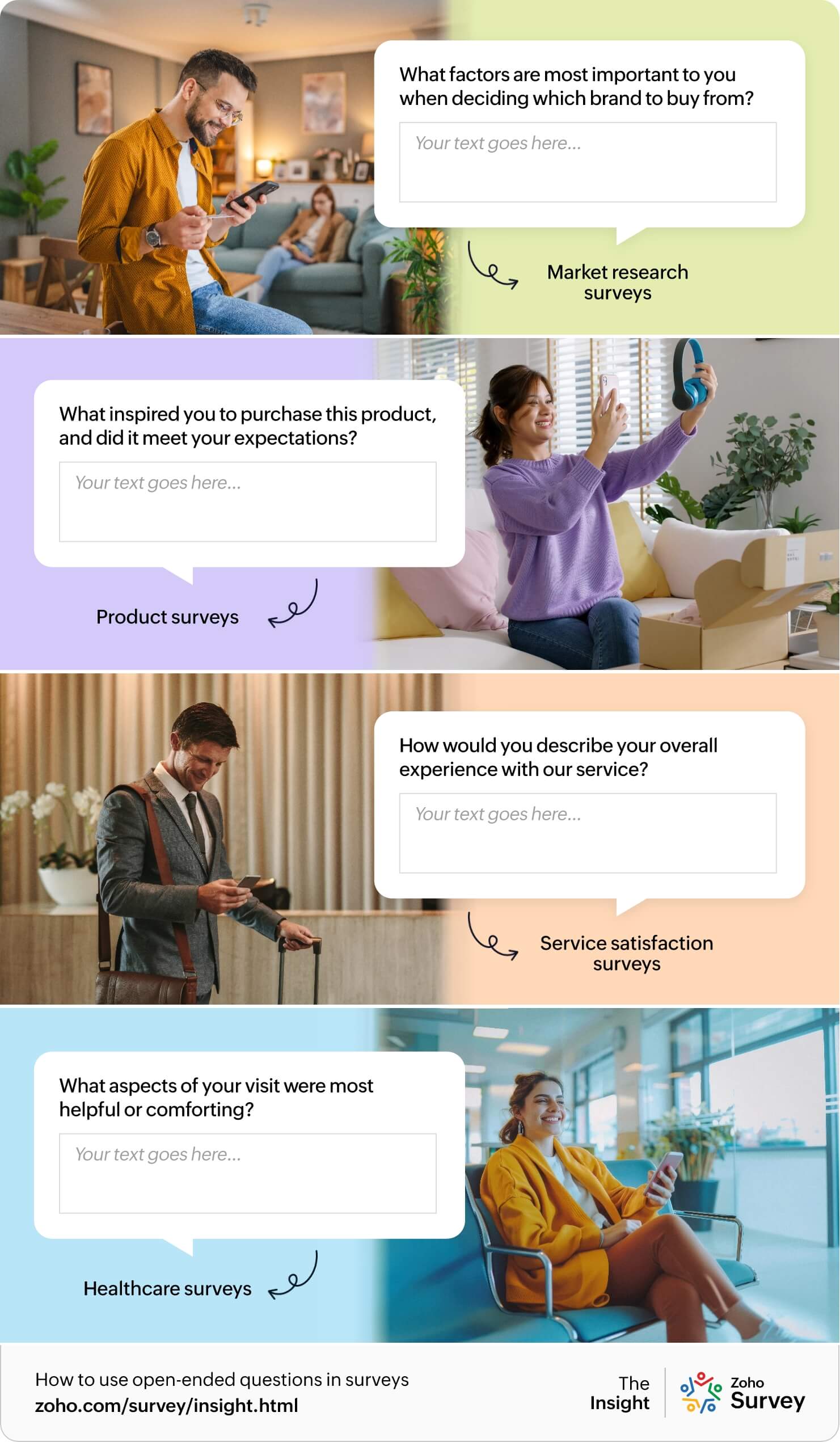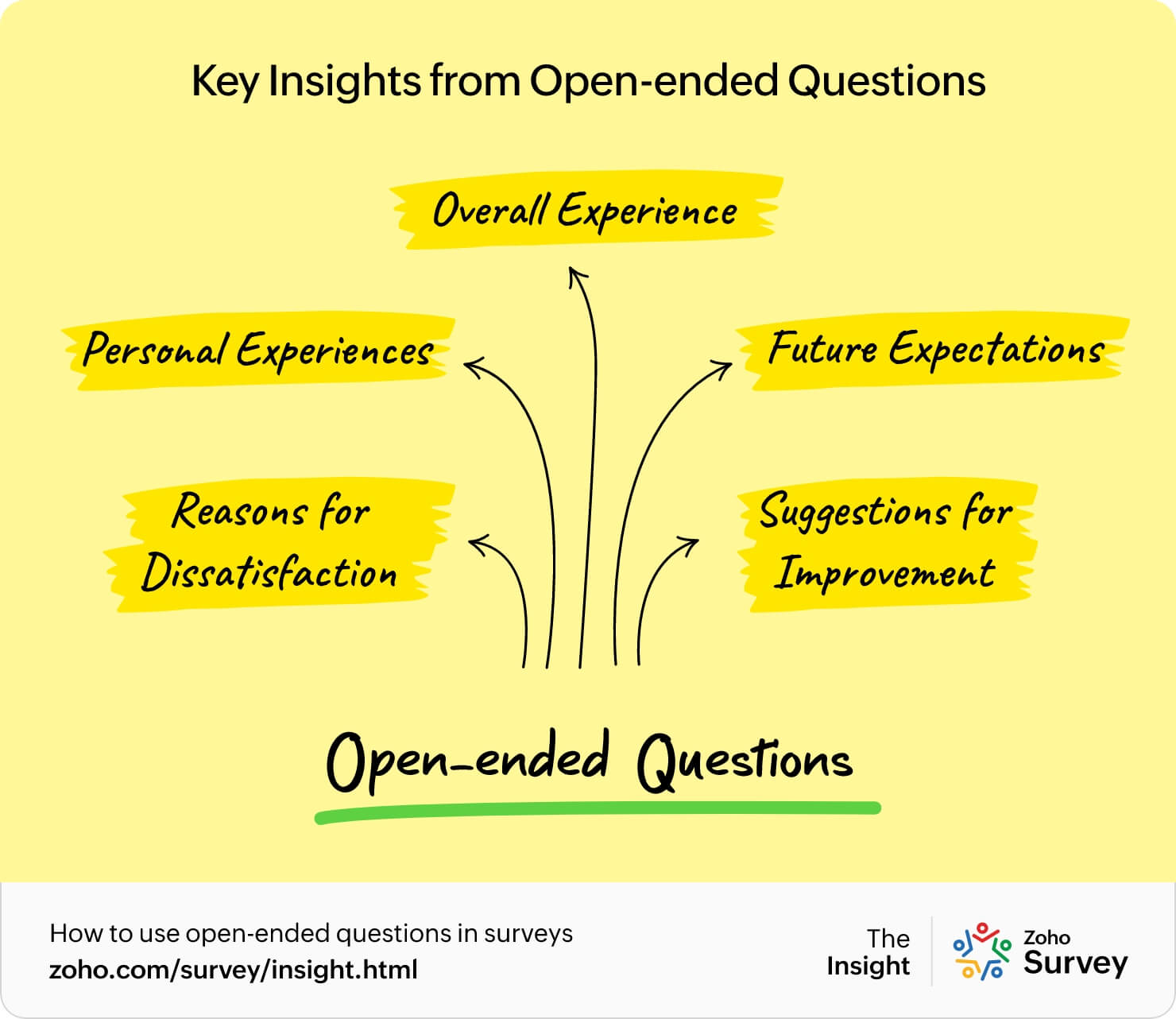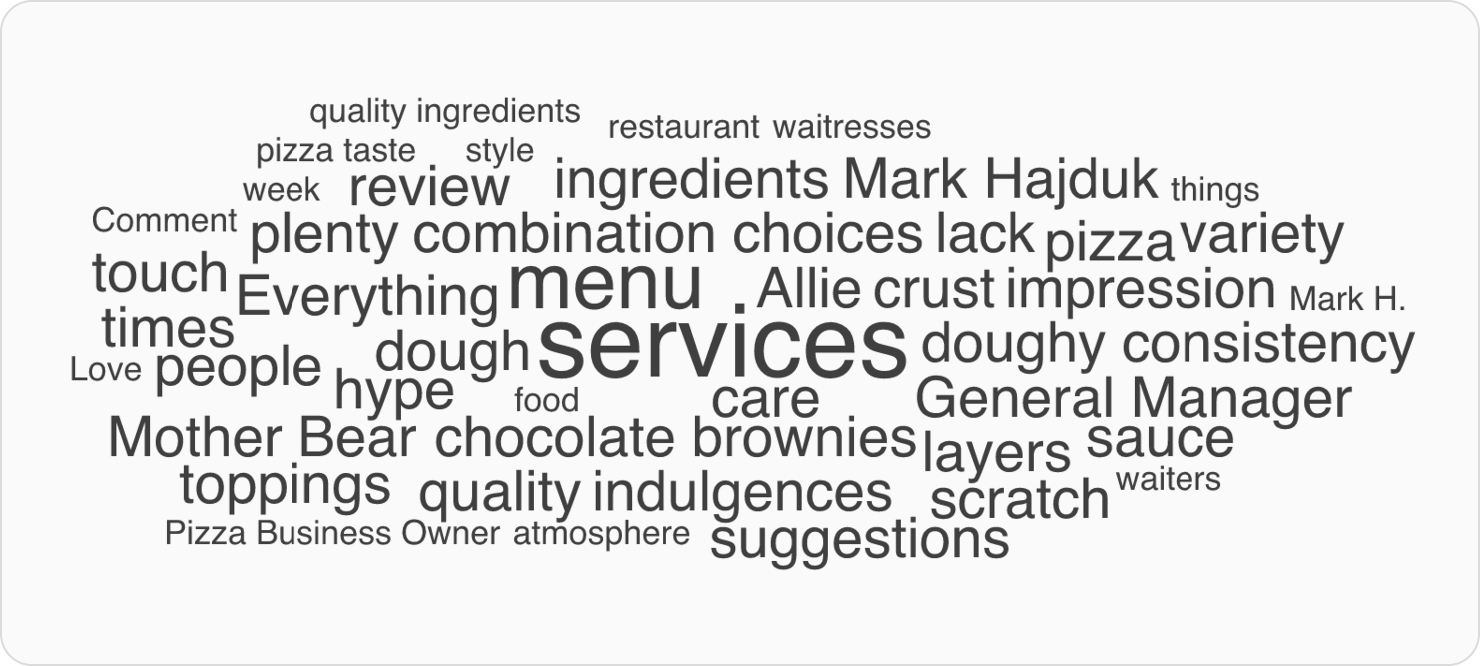- What exactly is an open-ended question?
- What kind of insights can you gather from open-end questions?
- How can you use these questions in different types of surveys?
- Why should I use open-ended questions in my survey when closed-ended questions are quicker to analyze?
- Where do open-ended questions fit best?
- How do you avoid using too many open-ended questions?
- How Zoho Survey helps in turning open-ended feedback into insights
What exactly is an open-ended question?
An open-ended question is one where no specific answers are provided. Instead, your survey participants are encouraged to respond with their own thoughts, opinions, or experiences. It gives them a blank space to share exactly what they think or feel about a topic.
What kind of insights can you gather from open-ended questions?
Deeper understanding
Open-ended questions help you really get what someone’s saying by letting them explain in detail or tell a story. For instance:
Can you describe a specific instance when [topic] positively impacted your life?
What are your biggest concerns or frustrations with our product?
These questions can reveal personal anecdotes and emotional connections related to the topic. This approach can help you uncover pain points and identify areas where improvements are needed.
Unexpected insights
Open-ended questions let you hear lots of different views. Sometimes, people bring up stuff you never would have thought about otherwise.
For example, you might ask
What are your biggest fears or worries about the future of [topic]?
This question will help you to identify unexpected outcomes or unintended consequences of a change.
Identify patterns
Open-ended questions help you see if there are common ideas or themes in what people say, like connecting the dots in a puzzle.
You can ask your customers questions like
What are your favorite features in our product?”
What are your favorite features in our product?”
Innovative solutions
These questions can inspire creative ideas, like when someone suggests something wild that ends up being brilliant.
Let’s say you include a question like,
What are some of the biggest obstacles or challenges you face when using the product?
This question can help you identify potential barriers or roadblocks to implementing a solution.
How can you use these questions in different types of surveys?

Market research surveys
Open-ended questions let people share detailed thoughts about what they like or don’t like to help companies understand customers better. For instance, in a survey about favorite clothing brands, an open-ended question might ask participants to describe why they prefer a particular brand over another or how they feel about a current design trend.
Product surveys
Open-ended questions give users a chance to say what they love or hate about a product, so you can make improvements based on their feedback.
Service satisfaction surveys
Customers can share their experiences in detail to explain what went well or what needs fixing. For example, in a restaurant feedback survey, an open-ended question could help you to gather insights on the customer’s overall dining experience and suggest improvements.
Healthcare surveys
Patients and visitors can share their experiences and concerns in detail, which will help you offer high-quality care. In a survey about a hospital visit, you can include an open-ended question that asks patients to describe their overall experience and suggest ways to enhance patient care.
Why should I use open-ended questions in my survey when closed-ended questions are quicker to analyze?

Patients and visitors can share their experiences and concerns in detail, which will help you offer high-quality care. In a survey about a hospital visit, you can include an open-ended question that asks patients to describe their overall experience and suggest ways to enhance patient care.
Well, let’s say you are designing a new app, and you want to know what features people would like to see. Sure, you could give them a list of options to choose from, but what if there’s something they want that you didn’t think of? That’s where open-ended questions come in handy. They let people tell you exactly what’s on their minds and provide insights you might not have considered otherwise.
People might mention features they love, things they wish were different, or even ideas for new products or services. It’s a gold mine of insights waiting to be discovered.
Whether you’re trying to understand customer satisfaction, gather ideas for improvement, or just get a sense of what people think, open-ended questions are a great go-to option.
Where do open-ended questions fit best?
Open-ended questions shine in situations where you want detailed feedback, nuanced insights, or a deeper understanding of your audience. Let’s break it down with an example.
Let’s say you run an online store selling clothing. You want to understand why some customers abandon their carts before completing a purchase, beyond just knowing the items left behind.
Instead of just asking, “Did you have any issues during checkout?” you decide to use an open-ended question: “What made you hesitate or decide not to complete your purchase today?”
How do you avoid using too many open-ended questions?
There’s no one-size-fits-all answer to this question. It depends on the length of your survey and how much time you think people will be willing to spend typing out their responses. A good rule of thumb is to sprinkle them throughout your survey, maybe one or two every few questions.
While open-ended questions offer nuanced insights, it’s essential to strike a balance. Including too many can overwhelm respondents and lead to survey fatigue. Start with some easy, multiple-choice questions to warm them up. Then, once they are comfortable, drive them to dig deeper with the open-ended ones. And remember, don’t overload your survey, or people might get tired of typing and leave the survey incomplete!
How Zoho Survey helps in turning open-ended feedback into insights
Now, this is where the real fun begins!
Response summaries
provide summaries of open-ended responses, allowing you to quickly review the main points raised by respondents without having to go through individual responses manually.
Word clouds

Word clouds visually represent the most frequently occurring words or phrases in open-ended responses, giving you a quick overview of common themes or topics mentioned by respondents.
Text analysis tools

Zoho Survey reports can include text analysis tools that automatically categorize open-ended responses based on sentiment (positive, negative, or neutral) or identify common keywords and phrases. This helps users understand the overall tone and content of the feedback received.
Charts and graphs
Zoho Survey reports offer various chart and graph options to visualize the distribution of open-ended responses across different categories or themes. This makes it easier to identify trends, patterns, and outliers in the data.
Customize your reports
reports enables you to compare open-ended responses across different survey questions, segments, or time periods. This helps you identify correlations, discrepancies, or changes in respondent feedback over time.
So, go ahead, ask away, and let the insights roll in!

